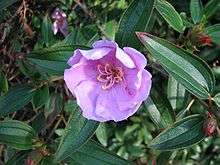Melastoma affine
| Melastoma affine | |
|---|---|
 | |
| Scientific classification | |
| Kingdom: | Plantae |
| (unranked): | Angiosperms |
| (unranked): | Eudicots |
| (unranked): | Rosids |
| Order: | Myrtales |
| Family: | Melastomataceae |
| Genus: | Melastoma |
| Species: | M. affine |
| Binomial name | |
| Melastoma affine D. Don[1] | |
| Synonyms | |
|
Melastoma denticulatum | |
Melastoma affine, also known by the common names blue tongue or native lassiandra, is a shrub of the Melastomataceae family. Distributed in tropical and sub-tropical forests of India, South-east Asia and Australia, it is a plant of rainforest margins. Bees are the principal pollinators of this species.
Taxonomy
Melastoma affine was first described by Scottish botanist David Don in 1823.[1] The taxonomy of the genus Melastoma is tricky, requiring a complete revision.[2][3] Early genetics studies were published from 2001,[4] through to recently,[5] but a revision based on them has yet to be. In 2001 Karsten Meyer proposed a revision in which this species and other species were subsumed within the species Melastoma malabathricum.[6]
In Australia, currently most authorities do not accept this; instead the naturally occurring populations in WA, NT, Qld and north eastern NSW remain recognised as this species M. affine,[1][7][8] except by authorities in Qld.[9][10]
Description
It is found as a shrub to 2 m (6.6 ft) in height. The leaves are ovate and measure 6 to 12 cm (2.5 to 4.5 in) in length, and 2–4 cm (1–1.5 in) wide. Covered in fine hair they have longitudinal veins. Appearing in spring and summer, the flowers occur on the ends of branchlets and are purple with five petals and sepals.[8] There are two sets of distinctive stamens, five opposite the petals and five opposite the sepals. The antesepalous ones have long anthers with a bilobed appendage at their base.[3] It produces 8mm long purple fruits that split open to expose a redish to purple flesh with many small seeds.[11] The common name "blue tongue" refers to the edible purplish-black pulp within the fruit capsules which stains the mouth blue.[12]
Distribution and habitat
Melastoma affine is found from India through southeast Asia, Malaysia, Indonesia and into Australia.[13] Within Australia, it is found from the Kimberleys in Western Australia,[13] across the Northern Territory and Queensland,[14] and reaches as far south as Kempsey on the New South Wales mid north coast.[8] It grows in wet areas in sclerophyll forest.[8]
M. affine is important as being a pioneer species that colonises disturbed wet-sclerophyll and rain forest habitats in the Australasian region.[13] It produces no nectar - giving pollinators large amounts of pollen instead, which must be extracted through pores on the anthers.[13] Melastoma affine is pollinated by bees, particularly Xylocopa bombylans, X. aff. gressittii, Amegilla anomola and Nomia species.[13] Honeybees outcompete native bees for pollen at flowers, impacting on the species' reproduction.[15]
Cultivation
A fast-growing and adaptable shrub, Melastoma affine is sometimes seen in cultivation. It can be propagated by seed or cuttings.[14]
References
- 1 2 3 "Melastoma affine D.Don". Australian Plant Name Index (APNI), IBIS database. Centre for Plant Biodiversity Research, Australian Government.
- ↑ Whiffin, Trevor (1990). "Melastoma". Flora of Australia: Volume 18: Podostemaceae to Combretaceae. Flora of Australia series. CSIRO Publishing / Australian Biological Resources Study. pp. 247–248. ISBN 978-0-644-10472-2.
- 1 2 Whiffin, Trevor (1990). "Melastoma affine". Flora of Australia: Volume 18: Podostemaceae to Combretaceae. Flora of Australia series. CSIRO Publishing / Australian Biological Resources Study. page 248, figs 61, 86, map 346. ISBN 978-0-644-10472-2.
- ↑ Clausing, G.; Renner, Susanne S. (2001). "Molecular phylogenetics of Melastomataceae and Memecylaceae: implications for character evolution". American Journal of Botany. 88 (3): 486–498. doi:10.2307/2657114. Retrieved 19 June 2013. – see also the erratum.
- ↑ Michelangeli, Fabián A.; Guimaraes, Paulo J. F.; Penneys, Darin S.; et al. (2013). "Phylogenetic relationships and distribution of New World Melastomeae (Melastomataceae)". Botanical Journal of the Linnean Society. 171 (1): 38–60. doi:10.1111/j.1095-8339.2012.01295.x. ISSN 1095-8339. Retrieved 18 June 2013.
- ↑ Meyer, Karsten (2001). "Revision of the Southeast Asian genus Melastoma (Melastomataceae)". Blumea. 46 (2): 351–398.
- ↑ Hosking, J. R.; Conn, B. J.; Lepschi, B. J.; Barker, C. H. (2011). "Plant species first recognised as naturalised or naturalising for New South Wales in 2004 and 2005" (PDF). Cunninghamia. 12 (1): 85–114. Retrieved 18 June 2013.
- 1 2 3 4 Wilson, Peter G. (July 2001). "Melastoma affine D.Don – New South Wales Flora Online". PlantNET - The Plant Information Network System. 2.0. Sydney, Australia: The Royal Botanic Gardens and Domain Trust. Retrieved 18 June 2013.
- ↑ Hyland, B. P. M.; Whiffin, T.; Zich, F. A.; et al. (Dec 2010). "Factsheet – Melastoma malabathricum subsp. malabathricum". Australian Tropical Rainforest Plants. Edition 6.1, online version [RFK 6.1]. Cairns, Australia: Commonwealth Scientific and Industrial Research Organisation (CSIRO), through its Division of Plant Industry; the Centre for Australian National Biodiversity Research; the Australian Tropical Herbarium, James Cook University. Retrieved 18 June 2013.
- ↑ Bostock, P.D.; Holland, A.E., eds. (2010). Census of the Queensland Flora 2010. Brisbane: Queensland Herbarium, Department of Environment and Resource Management. p. 101. Retrieved 18 June 2013.
- ↑ "Blue Tongue - Native Lassiandra - Melastoma affine". Fruit and Nut Trees - Fruit Bearing Plants. Retrieved April 24, 2014.
- ↑ Low, Tim (1991). Wild Food Plants Of Australia. Australia: Angus & Robertson. p. 59. ISBN 0207169306.
- 1 2 3 4 5 Gross, Caroline L. (Dec 1993). "The Breeding System and Pollinators of Melastoma affine (Melastomataceae); A Pioneer Shrub in Tropical Australia". Biotropica. 25 (4): 468–74. doi:10.2307/2388870. JSTOR 2388870.
- 1 2 Elliot, Rodger W.; Jones, David L.; Blake, Trevor (1993). Encyclopaedia of Australian Plants Suitable for Cultivation:Volume 6 - K-M. Port Melbourne: Lothian Press. p. 375. ISBN 0-85091-589-9.
- ↑ Gross, Caroline L.; Mackay, D. (1998). "Honeybees reduce fitness in the pioneer shrub Melastoma affine (Melastomataceae)". Biological Conservation. 86 (2): 169–78. doi:10.1016/S0006-3207(98)00010-X. Retrieved 18 June 2013.